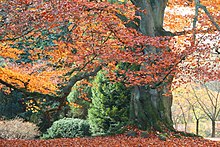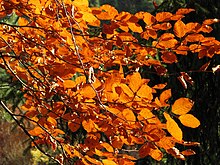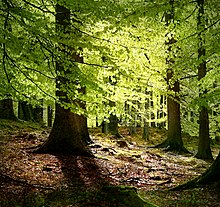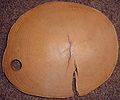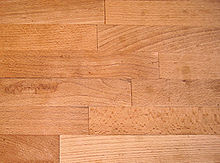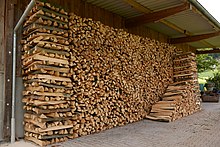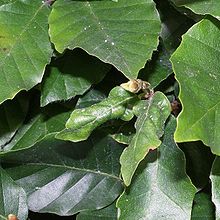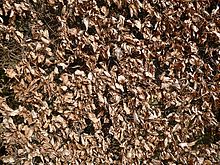European beech
| European beech | ||||||||||||
|---|---|---|---|---|---|---|---|---|---|---|---|---|
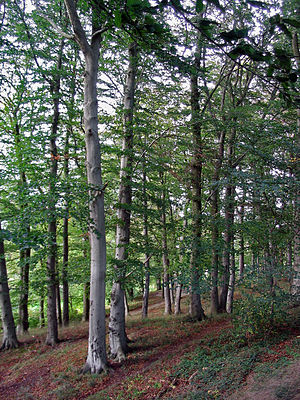
Fagus sylvatica |
||||||||||||
| Systematics | ||||||||||||
|
||||||||||||
| Scientific name | ||||||||||||
| Fagus sylvatica | ||||||||||||
| L. |
The common beech ( Fagus sylvatica ) is a deciduous tree from the beech genus ( Fagus ) native to large parts of Europe . In colloquial language it is usually referred to as beech . The botanical spelling of red beech emphasizes that it belongs to the beech genus. (The home also in Europe hornbeam , however, is a separate genus in the family of the birch family .) With a 15% share of the European beech is the most common deciduous tree in the forests of Germany. In Switzerland their share is 19%, in Austria 10%. The part of the name "red" refers to the sometimes slightly reddish color of the wood. Beeches with red leaves belong to the copper beech variety . Because the common beech is the only type of beech ( Fagus ) native to Central Europe , the addition to the species name is often omitted.
Mixed deciduous forests rich in red beech are seen as the potential natural vegetation of large parts of Central Europe. The common beech is considered a pointer plant for an Atlantic climate.
description
Shape and stature
The common beech grows as a deciduous tree and can reach heights of up to 30 m, in dense forests up to 45 m. The trunk diameter can be up to 2 m outdoors. It can live up to 300 years; in individual cases older specimens were also found. In the Kalkalpen National Park in Upper Austria , a 546 year old beech was discovered, which is considered to be the oldest red beech in continental Europe.
The crown of a fully grown beech can shade up to 600 m², it blooms and gives fruit at an age of around 30 to 200 years. At the age of less than 30 to 50 years it is fast-growing in ideal locations with an annual height increase of 40 to 70 cm, with a slightly sparse and upright crown and initially clearly laterally growing branches . If it competes with other trees, it is one of the late dynamic climax trees, which grow in length from around 45 years of age. The first shoot between April and May is pushed very quickly up to a length of 40 cm and initially hangs down slightly. Then, as with all woody plants, lignin is increasingly formed and the branches stand up. The growth in length is complete after three to five weeks. Sometimes a so-called St. John's shoot can be observed towards the end of June .
The vigor decreases with age, and by the age of around 100 to 150 years a European beech can already reach its maximum height in the open. After that, it grows more slowly and, with decreasing vitality from around 200 years of age, gets an increasingly dense crown. The new shoot then becomes shorter and finally only a few centimeters are pushed again. Free-standing specimens can develop spreading, regular and finely branched oval crowns with a diameter of 20 to 30 m with lower branches reaching almost to the ground. Older strong branches are almost horizontal, expansive and regular, arranged alternately. The young shoot forms an upwardly directed main bud, the so-called main branch, and a side bud. The lack of light inside the crown forces the tree to branch out symmetrically and finely with the leaves clearly horizontal, while the crown inside does not allow any new shoots due to the darkness.
In the forest standing, however, it grows thin and the lower branches die from lack of light early on. The base of the crown is often only 10 to 20 m high. It only reaches a maximum crown diameter of 20 to 30 m in the very old forests, which have become rare, when other trees in the vicinity die off. Due to the competitive pressure for light, the strong branches in the forest are sometimes more inclined upright than horizontal. Due to its thickness, symmetry and light ocher autumn color, the common beech is a popular park tree.
Bark ("bark")
The thin bark of the young twigs is initially dark green to black and smooth, but after a few weeks it becomes lighter. On the branches and trunk, it is usually light gray with scars from branches that have fallen away over decades and that look like small wrinkles on the trunk. As the trunk and branches grow in thickness , the bark expands with it, forming only the finest longitudinal cracks. The dying phellem , the so-called cork, does not clearly flake off, but rather disintegrates into fine, light-gray dust. In old beech trees, the bark at the base of the trunk becomes coarser and cracked, but in contrast to most other tree species, it remains thin and smooth on the main trunk into old age. A variety of the common beech, the stone beech ( Fagus sylvatica var. Quercoides ) generally forms a thick, very cracked bark .
leaf
The leaves are egg-shaped, pointed to pointed or pointed and are wedge-shaped to rounded, sometimes heart-shaped or crooked. They are between 7 and 10 cm long and up to 5 cm wide. The leaf margin is wavy to flared, sometimes slightly notched, toothed or serrated and ciliate. There are short teeth at the ends of the six to seven lateral nerves. The underside of the blade is loosely to densely hairy on the main nerves, the nerve axils and on the intercostal fields. The petiole is 1.0 to 1.5 cm long and hairy. The young leaves are fresh green, sometimes pale, and silky hairy. In summer the leaves are glossy dark green at the top and light at the bottom. In autumn they first turn pale yellow, later orange-red to red-brown. In many cases, the dried up leaves remain on the branches over the winter.
Flower buds, inflorescence and flower
A branch with two male and one female inflorescence. 1 , 2 and 3 male flowers; 4 female flowers.
B Branch with closed and open fruit cluster , each with two beechnuts.
6 cross sections and 7 whole beechnuts.
The common beech flowers from the age of 30 to 50 years. It is a monoecious ( monoecious ) tree; the male and female flowers can therefore be found on a tree. The flower buds are light brown, spindle-shaped, narrow and pointed. They are wrapped in 2 to 3 oppositely arranged, double bracts that overlap like scales. The flowers appear at the same time as the leaves shoot from April to May. The flowers of one sex are grouped together in inflorescences . The clusters of male flowers are 3 to 5 cm long and drooping, with each male flower containing 4 to 7 stamens . Three pink stigmas protrude from each of the upright female flowers .
fruit
Also known as beechnuts known fruits sit in pairs in a short-stalked, weichspitzigen, four-lobed, about three to seven centimeters long fruit stand together. Raw beechnuts contain trimethylamine (also called fagin) and are therefore slightly toxic. A slight toxic effect is also due to the fact that raw beechnuts contain a lot of oxalic acid .
The beechnut harvest is often particularly plentiful after a hot, dry year. Such mast years are part of the survival strategy of beeches. If they produced the same number of seeds every year, mice , wild boars and birds would adapt their populations to this constant food supply. The over-abundant formation of seeds ensures that more seeds are formed than the animals can eat. However, fattening years are a heavy burden for the trees, since a tree uses around two thirds of the annual gain of assimilated sugar for beechnut production; therefore, after such a year, beechnuts are formed to a much lesser extent, even if the climatic conditions are good.
Even in normal beechnut years, animals contribute to the natural rejuvenation of the populations by spreading in hiding . Squirrels , bank mice , wood vole and yellow-necked mouse create beechnut depots as winter supplies, but often forget their hidden fruits, which can then sprout.
Chromosome number
The number of chromosomes is 2n = 24.
Distribution and location


During the last glacial period , the common beech was displaced from Central Europe. It survived in the Mediterranean and began to recapture the European range around 10,000 years ago. In the sediments of the silted-up Luttersee in Eichsfeld near Göttingen , their pollen first appeared in the later warm period around 4800 years ago.
The distribution area of the common beech extends from southern Scandinavia to Sicily today . In eastern Central Europe and southern Scandinavia it occurs up to an altitude of 500 m ; in Western Europe up to 1500 m , as on the Feldberg (Black Forest) and in the southern Alps at least up to 1850 m , on Monte Baldo (Lake Garda) the beech forms the tree line, not the spruce. In the Allgäu Alps it rises up to 1500 meters above sea level, whereby there are clear differences in the altitude distribution depending on the exposure (south side or north side of the mountain). This difference can be several 100 m. In east-west direction their range extends from the Atlantic coast of France, where they very often happens to the Vistula River valley in northeastern Poland and the Carpathian Mountains in western Ukraine. In subcontinental Poland it only occurs in protected mixed forests . An isolated relic occurrence in the mountains of the Crimea on the Black Sea presumably includes mainly hybrids with the oriental beech , the population was partially understood as an (intermediate) species and then called Fagus taurica Poplavska.
In Germany , the common beech occupies 1.68 million hectares, 15.4 percent of the total forest area. This makes it the most common deciduous tree species in German forests . The largest German beech forest areas are found in Bavaria with 338,000 hectares (13.6 percent of the state forest area) , with 284,000 hectares (21.5 percent of the state forest area) in Baden-Württemberg and with 255,000 hectares (30.1 percent of the state forest area) in Hesse . Between 2002 and 2012, the beech area in Germany increased by 102,000 hectares. The average increase in European beech is 10.3 solid cubic meters per hectare and year.
The common beech is a distinct pointer type of humid-temperate climate , the so-called nemoral zone . It is bound to euoceanic to suboceanic climates . They require over 650 mm of annual rainfall and an annual average temperature of over 8 ° C to thrive . The distribution of pure beech stands is limited to the east by the transition to the subcontinental climate.
The common beech prefers nutrient-rich, slightly acidic to lime-rich, cohesive, moderately podsolized sand to clay soils. In drier regions it is bound to cohesive (loamy) soils. Waterlogging and strongly fluctuating groundwater levels, such as those that prevail in alluvial forests , are just as unsuitable as long periods of drought.
The European beech is relatively shade-tolerant when young and is therefore one of the shade tree species . However, in old age it needs more light. Due to its high shade tolerance and at the same time the strong shadow effect of its wide crowns, it can displace other tree species in the locations that are suitable for them. Under natural conditions, pure beech forests or mixed beech forests are considered to be the typical potential natural vegetation ( climax vegetation ) in most of the lowlands of Western Europe and also in Germany, but only if one assumes that herbivores would not have had sufficient influence to clear the forests and to open countries as the megaherbivore hypothesis represents. The fact that the European beech did not suddenly appear dominant in pollen diagrams until humans began to settle down about 3500 years ago could be used as an argument for this controversial theory, according to which beeches only existed as individual specimens or groups of trees in these pasture landscapes .
Pointer values according to Ellenberg
| factor | value | scale | Designation / explanation |
|---|---|---|---|
| Light number | 3 | 1-9 | Shade plant |
| Temperature number | 5 | 1-9 | Moderate heat pointer |
| Continental number | 2 | 1-9 | oceanic |
| Humidity number | 5 | 1-12 | Freshness pointer |
| Response number | X | 1-9 | indifferent |
| Nitrogen number | X | 1-9 | indifferent |
| Life form | P | - | Phanerophyte |
On extensively grazed areas, the common beech is inferior to the sessile oak ( Quercus petraea ). According to the controversial mega- herbivore hypothesis , which assumes that large herbivores (such as bisons, aurochs, red deer and wild horses) had a decisive influence on the vegetation of Central Europe in prehistoric times, the dominance of the European beech cannot be regarded as natural. According to this hypothesis, the natural vegetation of Central Europe was not characterized by dense, closed forests, but by semi-open forests such as were found extensively in hat forests until the early modern period .
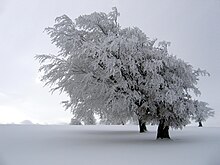
The beech forests in Central Europe can be roughly divided into three types depending on the location:
- The "beech forests" are bound to the occurrence of calcareous soils . This type of forest is therefore particularly widespread in the Swabian Alb , the Franconian Alb , the Weser Uplands and in the Alps . Ash and maples are mixed in with the beech in humid locations .
- The brown earth- beech forests would be particularly common in northern Germany, but also on Vogelsberg in Hesse, for example . Beeches can develop their maximum potential on brown earth. Ash and maples can only exist here next to beech trees on particularly nutrient-rich and moist locations, while sessile oak and rarely linden trees are mixed in on very poor and dry locations . Only a few remains of these beech forests are left; most of them were converted into agricultural land at an early stage or replaced by spruce forests .
- The acidic beech forests grow on acidic, rather nutrient-poor soils, such as those formed from older moraines , decalcified loess , sandstone and slate . They are particularly widespread in the northern German lowlands . Sessile oak in particular is added to the less nutrient-poor locations of this type of forest. These forests too have largely been cleared or replaced by spruce forests.
In mountainous areas, namely in the montane altitude , the common beech occurs mostly mixed with silver fir ( Abies alba ) and spruce ( Picea abies ) and forms with these the " spruce-fir-beech forests ".
Hazard and protection
general situation
The common beech is widespread throughout Germany and Europe. Since the EU has recognized its responsibility to protect the beech forests, several habitat types that contain the beech forest have been placed under protection in the European Habitats Directive . These include the grove beech forest (9110), the Atlantic acidic beech forest with undergrowth of holly and occasionally yew (9120), the woodruff beech forest (9130), the Central European subalpine beech forest with maple and Rumex arifolius (9140) and the Central European orchids -Kalk-Buchenwald (9150).
Exposure and Diseases
The hazards and diseases of the European beech are sometimes viewed as " complex beech disease" or as a complex disease . Particularly dry periods can lead to losses in the fine root area and weakening of the trees. As a result, the weakened trees are more susceptible to further damage and disease. The endangerment of European beech stands has been identified through infestation with fungi. Several species of Phytophthora are known to do so. Among the insect pests to the beech trees are Buchenspringrüssler (Rhynchaenus fagi) , the Small book bark beetle (Taphrorychus bicolor Hrbst.) And the Agrilus viridis (Agrilus viridis L.) detected. The drought and heat in Europe in 2018 , e.g. B. in Switzerland, especially the beeches affected.
Forest management of beech forests
In forestry, too, beech forest stands are being rejuvenated under the protection of old trees. For the success of such a targeted rejuvenation, the correct dosage of the incident light is crucial. If the opening is too wide, the seedlings are at risk of frost and severe obstruction from the undergrowth that then develops. Too little light, on the other hand, causes the seedlings to wither or cripple.
Beech forests still need regular and careful thinning afterwards in order to provide economically valuable trees. Trees standing in close association provide long and knot-free trunks, as are necessary, for example, in high-quality furniture construction. However, under the strong competitive pressure that arises with such a dense stand, the trees develop irregular crowns. This in turn leads to strong tensions in the wood, so that sawed wood works hard and splits or warps like a propeller. Trees that are too far apart, on the other hand, branch out too much, which makes them unsuitable for high-quality recycling.
Mull from beech leaves is also an ideal germination bed for other tree species in Central Europe, such as spruce or silver fir . Beeches generally have a soil-improving effect, as their leaves degrade in one to two years. The silvicultural value of beeches is now undisputed after red rot , windthrow and bark beetles have made it clear how vulnerable, in particular, pure spruce stands are. However, the beech is not spared from diseases either. In Belgium alone, between 2000 and 2002, there were over a million cubic meters of damaged wood due to beech death.
Characteristics of the wood
The term red- beech is actually misleading, because the wood is only slightly reddish shimmering. A deeper shade of red is created by so-called steaming . In doing so, the wood is relieved of its strong tendency to warp and crack.
The wood is fine-pored and usually evenly grained, and can be easily planed and turned. The beech is one of the mature trees, so it has a homogeneous color structure over the entire trunk cross-section. However, it is one of the trees with an optional formation of a color core. This is known as the red heart. The red heart occurs more frequently with increasing age and with a larger diameter of the tree. The red-hearted wood of the beech achieves lower prices than white wood. However, this so-called core beech is now increasingly in demand in individual furniture production. Due to its great hardness , according to Brinell 34 N / mm², it is also often used as parquet . The flexural strength is high, but when damped, the wood is flexible and also very plastic , which is directly related to the short wood fiber length. For this reason, curved molded parts are made from the wood, for example seating furniture with anatomically curved elements. Michael Thonet invented a process for bending beech wood in 1830 and used it to manufacture his now world-famous Thonet chairs.
European beech with pronounced red heart ( heart beech )
Beech as a timber supplier
As a supplier of timber, the common beech was inferior to the oak in the traditional economy . The oak offered a more versatile wood, which, unlike the less rot-resistant beech wood, was also suitable for shipbuilding and exterior construction. The oak also supplied the acorns for the acorn fattening, which played a major role in traditional pig farming . Beech wood was superior to oak wood only in terms of calorific value. For a long time, therefore, the beech was neglected in favor of the oak. The forest engineer Christian Küchli , who has dealt intensively with the history of European forest trees, speaks of a centuries-long eradication of the beech.
Larger forestry importance was the book only with the discovery that a creosote - impregnated railway sleepers from beech wood protects long 40 years before fungal attack. This made them just as durable as those made from oak; the forest companies were able to achieve such attractive prices for their beech wood that afforestation with this tree species seemed worthwhile again. Around 1930 only half of the beech wood felled was burned; the other half was used for railway sleepers and utensils such as wash troughs , clothespins , brushes and wooden spoons . This changed significantly when fossil fuels pushed back the firewood and, at the same time, plastic was obtained from oil , from which the objects of daily use previously made of beech wood were now made. Today the beech provides an important timber for the toy and furniture industry, parquet and stair construction. It is by far the most common type of deciduous tree in Germany and parts of western and central Europe and has an average share of 13.7% of the total German forest area, which in western Germany can even be up to 16%. The Buchholz is also equipped with a discount of about seven million square meters per year (about 1/6 of the total felling in Germany per year) one of the most important hardwoods as utility and industrial wood. In the mid-1980s, one to two million cubic meters of beech wood was felled in Switzerland. Only six percent of it was of high quality enough to be used in this way.
Beech wood is sold and processed as round as well as steamed and undamped sawn timber and as veneer ; It is the most important hardwood range in Germany. Besides spruce and pine wood , it is the most widely used industrial wood , but on the other hand it also supplies very popular special woods for numerous uses. The wood can only be used to a limited extent as construction and construction timber in solid form due to its inadequate stability. A total of more than 250 fields of application for beech wood are known. About half is here as pulpwood in the manufacture of chipboard and fiberboard , as well as for pulp production in the paper industry and in particular as dissolving pulp for the production of regenerated fibers like viscose and lyocell for the production of textiles and industrial yarns used. For many manufacturers, the wood of the red beech is also the first choice for the construction of bowling alleys .
Use as firewood

In large parts of Germany, beech wood is by far the most common private and commercial firewood. On the one hand, this is due to the very widespread use of the common beech, its generally lower value in sales compared to many other hardwoods and its tendency to form crooked trunks with many branches when there is enough space and light, which are unsuitable for sale as trunk wood . This means that large quantities of beech wood are constantly accumulating when thinning stands, which is practically only suitable for use as firewood. It has an excellent calorific value of 19.7 MJ / kg, is characterized by very long, quiet burning, strong embers and a high calorific value . Due to the strong embers it is also very suitable for grilling . In addition, beech wood compared to many other types of wood, such as. B. oak , pine , larch , willow etc. can be split very well, both by hand with a splitting ax and wedge, as well as with mechanical support from a wood splitter . Beech wood tends to jump apart, especially in knot-free sections, when the slightest force is applied to a wedge, which can be quite dangerous in individual cases. An unsightly unraveling, such as B. with larch wood is rarely observed, which speeds up the splitting work and makes it immensely easier. The disadvantage of the beech tree is that it can cause difficulties, especially with very crooked and highly branched trunks, to place the split wood as seamlessly as possible in a straight joint, something that z. B. is usually easy to do with most conifers. The attached wood now works relatively hard, due to strong tension in the trunk as a result of asymmetrical crowns. This means that joints made of beech wood tend to warp and tend to be particularly violent, which can lead to the entire joint falling over, especially in an open position without support through a wall and at a great height (3 to 4 meters). Furthermore, unsplit, thin knots tend to "harden" in the course of drying in air, that is, to become rotten and crumbly inside, which reduces the calorific value and the wood is therefore of inferior quality. In the past, to counteract this, the bark was often removed in several places with a hatchet or scored with a knife to ensure more even drying.
The appreciation of the red beech as firewood led to specific forms of management that are rarely practiced today, in which the trees are repeatedly cut back ( coppice forest operation ). Tufted beeches and head beeches are the growth forms that result from this wood extraction. Tufted beeches develop when you either cut a young tree back to just above the ground and the tree sprouts again or you put several seedlings in a planting hole. Today there are only a few tufts of old houses, often these are as natural monuments under conservation . One speaks of head beeches analogously to the pollarded willows in beech trees that have been sawn off at chest height and that are allowed to grow again for renewed wood extraction. This leads to a stunted growth that gives the trees a bizarre look. Old specimens can still be seen in the Kottenforst of the city of Bonn and in the Sababurg primeval forest .
European beeches occasionally develop so-called forms of mourning . These are characterized by a short main axis from which many side branches extend with increased length but little growth in thickness. The long side branches hang down like a trail. Such mourning or pendula forms usually survive in the shelter of the woods. The leaves positioned on the umbrella-like overhanging branches can make better use of the scattered radiation penetrating through the upper stand. If the incidence of light changes because, for example, the top stock is reduced after a wind break, such weeping forms usually develop a steep upright growing shoot from dormant buds, which however often overhangs again after a corresponding increase in length. Such naturally occurring forms have been reinforced by breeding interventions and are occasionally found as solitary trees in parks and green spaces.
The beech and glass production
In the Middle Ages and the early modern period, wood ash was used for the manufacture of washing lye and glass . Beech stocks were cut down, especially for glass production. Two parts of beech ash with one part of sand made the green forest glass . The wood requirement for glass production was enormous. For 100 kilograms of pure potash , the glaziers needed around 200 cubic meters of wood. Another 100 cubic meters were needed to melt the potash into glass with quartz sand . Beech charcoal was also preferred for this.
The deforested beech trees were preferably reforested with spruce. In the process, a type of forest was created that was called "glass forest", "Glastobel" or "melt forest".
Use as food
Beechnuts , known in German-speaking Switzerland Book Lamb, played a role in the past in the human diet. Despite the slight toxicity , oil was pressed from the nuts in the 19th century and in the times of need after the Second World War, which was used both in cooking and as lamp oil. A handful of beechnuts can cause discomfort because of their ingredients ( trimethylamine , also called fagin, and hydrogen cyanide - glycosides ). The edible leaves of the beech are considered to be anti-inflammatory. They were chewed for gum problems or used as wound dressings for ulcers.
Use of the leaves as litter and forage
The soil-improving properties of the beech leaves, which decompose relatively slowly, were used in the mountain regions in the past. In these regions, it was often impossible to grow cereals that would provide enough straw for stables. Apart from the beech, deciduous tree species were rarely found in these regions. In many regions it has therefore been the custom for centuries for women and children to collect the beech leaves, which were then used as stable litter. The forests were regularly "cleared" and beech leaves were even put on the market. At the beginning of the 19th century, hundreds of shiploads were brought into trade from Lake Brienz in Switzerland . The removal of the leaves prevented natural rejuvenation, as the beech seedlings lacked natural protection from winter frosts. However, it was a necessity for farmers to run their farms economically. The foliage collection, like the acorn mast , had a reputation among forest scientists as early as the early 19th century for causing lasting damage to forests. Christian Küchli attributes the extensive avalanche barriers that are now necessary due to the lack of protective forest in the Lake Brienz region to centuries of overexploitation .
Young beech twigs tied in bundles and still bearing leaves were dried as winter fodder for the cattle. Goats in particular liked to eat these branches. But also in the spring, when the beech trees were sprouting, beech branches were fed to the cattle, because the milk yield could be increased.
The European beech as a habitat
The beech is a tree species that relatively few habitat specialists and endemics has. One possible reason for this is the comparatively late re-expansion of the species from the glacial refuges , which left little time for coevolutionary adaptations. Willner, Moser and Grabherr (2004) assume (for the flora ) a “ genetic bottleneck ”, because many ecological conditions were not given in the rather small refuge. The characteristic smooth bark offers bark-dwelling ( corticola ) species in particular less niche diversity than coarse-barked tree species (as demonstrated by Wirth in Walentowski et al. 2010 for the lichens flora). An overview of the biodiversity of the beech and beech forests is provided by Helge Walentowski et al. as well as Peter Meyer and Marcus Schmidt.
Herbivores

For approx. 170 to 180 invertebrate phytophages (insects and mites) the beech is one of their main host plants (overview at Brändle & Brandl). A good 100 other species occasionally feed on the beech, but occur more frequently on other species. The proportion of specialists who are monophagous (i.e. exclusively) found in European beech is around 27, i.e. H. with a share of approx. 15%. The beech is thus in the middle of the tree species, but clearly behind the oak species. The only monophagous beetle species living on beeches is the beetle weevil ( Rhynchaenus fagi ). 63 large butterfly species were found on beech, including no butterfly species and no monophagous species. Species that have the beech in their name, such as the beech toothed spinner ( Stauropus fagi ), also turned out to be polyphagous . An aphid species with beech as the exclusive host is the beech aphid .
Wood dwellers
Of the wood-dwelling beetle species, 323 show a certain bond with beech wood. Species living monophag on beech do not occur in Central Europe (there are such in the Carpathian beech forests). Of the 115 beetle species that are referred to as "jungle relic species", 63 are found on beech. Beetles that colonize dead wood often have a wide range of host plants and are more dependent on the age and size of the individual trees, the continuity of the habitat and the microclimate. The importance of the beech is significantly less than that of the oak, but is not noticeably low. In the comprehensive survey by Köhler, only 147 species were found among hundreds of wood-dwelling species that showed an exclusive connection (in Central Europe) to any deciduous tree species. Three of them were bound to red beech (for comparison: to oak 31).
Woodpecker holes in beech
Different types of woodpeckers build their nesting holes in beeches. In Central Europe these are mainly great spotted woodpecker , gray woodpecker and black woodpecker .
Soil flora
Compared to forests of other tree species in comparable locations, beech forests are poor in herb species, presumably due to the very shady canopy. In acidic beech forests, there are almost 20 herb species to be expected, in medium-sized forests with a good 25. Lime beech forests are more species-rich with around 30 species. In Europe, 110 species of forest floor herbs are characteristic beech companions. In the German low mountain ranges there are 46 to 52, in the lowlands 24 more. The mountains of the Northern Balkans, which are close to the suspected glacial refuge of the species, are rich in beech-accompanying species.
General biodiversity
It cannot be concluded from the information that beech forests are generally species-poor habitats. Particularly from investigations in natural forest reserves, impressively long lists of species are available for some of the forests that have been examined in more detail. How high the actual number of species is can hardly be stated with certainty. In two natural forest reserves in the Hessian Vogelsberg, 2328 and 1873 animal and plant species were found. It can be assumed, however, that the number of species is less related to the common beech tree species and that the species that occur are particularly weak in the beech forest. Walentowski et al. come to the conclusion: “For most of the observed species groups from flora and fauna, the beech forests of the west-central European lowlands and hills have comparatively few species that are bound to beech and, in contrast to south-east and south European beech forests, no regional endemics for them are known."
When comparing beech forests in Switzerland with (ecologically comparable) Carpathian primeval beech forests in Ukraine, Duelli et al. contrary to expectations in the jungle no higher numbers of species in numerous groups of invertebrates examined. Even the commercial forests tended to be a little richer in species. Comparisons, however, indicate that the number of specialized species (e.g. wood-dwelling beetles) is higher in the jungle.
Others

- The common beech was tree of the year 1990 in Germany and 2014 in Austria.
- A beech tree is shown on the reverse of banknotes worth 20 DM .
- Probably the most photographed beech in Germany was the Bavaria beech in Upper Bavaria, the last of which perished in 2013.
- The beech was the namesake of numerous localities or parts of the country. Examples are: Bucheggberg , Schönbuch , Schönenbuch , Buch am Irchel or Buochs .
- In the Eifel , especially in the Monschau Heckenland , beeches are used as hedges for field fencing and as high wind protection. Many houses there are surrounded by mighty hedges. The Meikleour Beech Hedge north of the Scottish city of Perth is considered the highest hedge in the world (up to 36 meters).
- The beech is extremely sensitive to earth accumulation in the root area. Raising the ground level by ten centimeters around the trunk can cause the beech to die off in the medium term.
- The so-called ripple beeches are a tree-related problem. This is a phenomenon that mostly occurs on trunks of 80 to 100-year-old European beech trees, the meaning and cause of which have not yet been fully clarified. The structure resembles ripple marks from the Wadden Sea or an old hand washboard (which is why the beeches affected are sometimes also referred to as "washboard beeches"). The “washboard pattern” only ever occurs on one side. Since it is the windward side of the tree at the examined locations (e.g. in Lübeck or in Hesse), it is assumed that the ripple formation has to do with the action of the wind. However, this cannot be the sole explanation for the ripple formation, especially since specimens of the same age without these distinctive ripples are sometimes in the immediate vicinity.
Ornamental varieties
There are numerous cultivated forms of the common beech that are used as ornamental trees in parks and gardens. They differ in the color of the leaves , the shape of the leaves or in their growth. The best known cultivars are:
- Weeping or hanging beech ( Fagus sylvatica forma pendula ), a breeding development of the natural pendula shape
- Copper beech ( Fagus sylvatica forma purpurea )
- Süntel beech ( Fagus sylvatica forma tortuosa )
- Column beech ( Fagus sylvatica cultivar 'Dawyck'), of which there is also the yellow-leaved variety columnar gold beech ( Fagus sylvatica cultivar 'Dawyck Gold')
- Slit-leaved European beech ( Fagus sylvatica forma laciniata )
- Fern-leaved beech ( Fagus sylvatica forma asplenifolia )
- Dwarf form of the fern-leaved beech ( Fagus sylvatica forma asplenifolia cultivar 'Mercedes')
- Gold beech ( Fagus sylvatica e.g. cultivar 'Zlatia' and 'Aurea' with golden yellow leaves)
- Dwarf beech ( Fagus sylvatica cultivar 'Felderbach')
history
swell
- Antiquity - late antiquity: Pliny 1st century
- Latin Middle Ages: Hildegard von Bingen 12th century --- Konrad von Megenberg 14th century --- Hieronymus Brunschwig 1500
- Modern times: Otto Brunfels 1537 --- Jean Ruel 1537 --- Hieronymus Bock 1539 --- Mattioli / Handsch / Camerarius 1586 --- Nicolas Lémery 1699/1721 --- Onomatologia medica completa 1755 --- v. Hasselt / Henkel 1862 --- August Husemann / Theodor Husemann 1871
Historical illustrations
Vergilius Romanus 5th / 6th century. Illustration for the 1st ecloge of Virgil's pastoral poems
Sebastian Brant 1502. Illustration for the 1st eclogue of Virgil's pastoral poems
Hieronymus Bock 1546. Illustration to the chapter Bůchbaum
Mattioli / Handsch / Camerarius 1586
literature
- Horst Bartels: Wood science. Ulmer, Stuttgart 1993. ISBN 3-8252-1720-5 , ISBN 3-8001-2648-6 .
- Gerhard Dönig: The park and garden forms of the red beech - Fagus sylvatica L. garden picture , Rinteln 1994, ISBN 3-928521-05-5 .
- Heinz Ellenberg : Vegetation of Central Europe with the Alps from an ecological, dynamic and historical perspective. 5th, heavily changed and improved edition. Ulmer, Stuttgart 1996, ISBN 3-8001-2696-6 .
- Norbert Kessel: The growth of wild beech trees and tree nursery plants (the effect of shoot pruning, root pruning, competition control, planting association was investigated). Dissertation, Freiburg 1994. (The complete text is on www.forstbuch.de: [1] ) (PDF; 411 kB) ( abstract ( memento from April 21, 2001 in the Internet Archive )).
- Reinhard Schober : The European beech 1971 . Series of publications by the Forest Faculty of the University of Göttingen and communications from the Lower Saxony Forest Research Institute. Vol. 43/44. Sauerländer, Frankfurt am Main 1972, ISBN 3-7939-0200-5 .
- Gerhard Veldmann, Helmut Vogt: The diseases and pests of the European beech (Fagus silvatica L.) . University Library, Jena 1985.
- ÖNORM B 3012: Types of wood - names, abbreviations and characteristics.
- Northwest German Forest Research Institute: Results of applied research on beech. Contributions from the Northwest German Forest Research Institute, Volume 3, Göttingen 2008 ISBN 978-3-940344-44-1 , online version (PDF; 5.8 MB).
Web links
- European beech. In: FloraWeb.de.
- European beech . In: BiolFlor, the database of biological-ecological characteristics of the flora of Germany.
- Profile and distribution map for Bavaria . In: Botanical Information Hub of Bavaria .
- Fagus sylvatica L. In: Info Flora , the national data and information center for Swiss flora . Retrieved October 3, 2015.
- Distribution in the northern hemisphere according to Eric Hultén
- Thomas Meyer: Data sheet with identification key and photos at Flora-de: Flora von Deutschland (old name of the website: Flowers in Swabia )
- The common beech - mother of the forest ( Memento from March 29, 2014 in the Internet Archive )
- Fagus sylvatica ( Memento from January 13, 2012 in the Internet Archive )
- Dossier on European beech: ecology, silviculture and forest protection
- German Forest Protection Association: The Beech (PDF; 496 kB)
- Information about the European beech , wald.de
- Buchenrotkern campaign of the Federal Nature Conservation Association
- Video: The common beech (Fagus sylvatica) during the year . Institute for Scientific Film (IWF) 1986, made available by the Technical Information Library (TIB), doi : 10.3203 / IWF / C-1612 .
- Video: Bud development in the common beech Fagus sylvatica . Institute for Scientific Film (IWF) 1983, made available by the Technical Information Library (TIB), doi : 10.3203 / IWF / C-1488 .
Individual evidence
- ↑ National Forest Inventory 3, 2012 . Retrieved March 12, 2015.
- ^ W. Russ: More forest in Austria. BFW-Praxisinformation 24, 2011, pp. 3–5. Source: Austrian Forest Inventory 2007/09.
- ↑ The oldest beech in Central Europe discovered in: Holz-Zentralblatt, August 30, 2019, p. 759.
- ↑ B. Felbermeier, R. Mosandl: Fagus sylvatica. In: Schütt, Weisgerber, Schuck, Lang, Stimm, Roloff: Encyclopedia of the deciduous trees. Nikol, Hamburg 2006, ISBN 978-3-937872-39-1 , pp. 241-260.
- ^ Erich Oberdorfer : Plant-sociological excursion flora for Germany and neighboring areas. 8th edition. Verlag Eugen Ulmer, Stuttgart 2001, ISBN 3-8001-3131-5 , p. 316.
- ↑ Association for the Protection of the Mountain World, download from www.vzsb.de/publikationen.php and online at ZOBODAT ; Herbert Reisigl (Innsbruck): From the flora of Monte Baldo p. 143
- ↑ Erhard Dörr, Wolfgang Lippert : Flora of the Allgäu and its surroundings. Volume 1, IHW, Eching 2001, ISBN 3-930167-50-6 , p. 425.
- ↑ Igor M. Patlaj, Svitlana A. Los, Roman M. Jatzyk, Ihor M. Shvadchak: Conservation of genetic resources of Social Broad Leaves in Ukraine. In: J. Turok, A. Kremer, S. de Vries (eds.): First Euforgen Meeting on social broadleaves. Bordeaux 1997.
- ↑ Dušan Gömöry, Ladislav Paule: Reticulate evolution patterns in western-Eurasian beeches. In: Botanica Helvetica. Vol. 120, No. 1: 2010, pp. 63-74.
- ↑ National Forest Inventory 3, 2012 . Retrieved March 12, 2015.
- ↑ FWM Vera: Grazing Ecology and Forest History. CABI Publishing, 2000, ISBN 0-85199-442-3 , p. 88.
- ↑ waldwissen.net: The Beech Complex Disease
- ↑ Thomas Jung, LWF aktuell 43, pp. 36–37, April 2, 2011 Phytophthora damages beech stocks throughout Bavaria ( Memento from April 7, 2019 in the Internet Archive )
- ↑ Horst Delb, FVA-Insight 1/2005, April 2, 2011 Bark brooder on beech after drought ( Memento from March 22, 2019 in the Internet Archive )
- ↑ The Swiss forest is dying. In: nau.ch . July 7, 2019, accessed July 7, 2019 .
- ↑ a b c D. Grosser, W. Teetz: Buche . In: Arbeitsgemeinschaft Holz e. V. (Ed.): Local timber (loose-leaf collection) . No. 7 . Information service wood, wood sales fund - sales promotion fund of the German forest and wood industry, 1998, ISSN 0446-2114 .
- ↑ Martin Kaltschmitt , Hans Hartmann and Hermann Hofbauer (eds.): Energy from biomass. Basics, techniques and procedures. 2nd Edition. Springer Verlag 2009, ISBN 978-3-540-85094-6 , p. 360.
- ↑ Dietrich Böhlmann: Why trees don't grow into the sky - An introduction to the life of our trees. Quelle & Meyer Verlag, Wiebelsheim 2009, ISBN 978-3-494-01420-3 , p. 7.
- ^ D. Willner, G. Moser, G. Grabherr: Alpha and Beta Diversity in Central European Beech Forests. In: Fitosociologia. 41 (2004): pp. 15-20, ( PDF ).
- ↑ a b Helge Walentowski et al .: Are the German forest nature protection concepts adequate for the preservation of the flora and fauna typical of beech forests? A critical assessment based on the origin of the forest species of the Central European low and hill country. In: Forest Archive. 81: 195217, 2010 PDF ( Memento from January 11, 2012 in the Internet Archive )
- ↑ Peter Meyer, Marcus Schmidt: Aspects of the biodiversity of beech forests - consequences for near-natural management. Contributions from the Northwest German Forest Research Institute 3 (2008): pp. 159–191 ( PDF ).
- ↑ Martin Brändle, Roland Brandl: Species richness of insects and mites on trees: expanding Southwood. In: Journal of Animal Ecology. 70 (2001): pp. 491-504, (PDF; 500 kB) .
- ↑ J. Müller: Forest structures as a control parameter for species communities in colline to submontane beech forests. Dissertation TU Munich, Faculty of Science Center Weihenstephan 2005, pp. 1–235, urn : nbn: de: bvb: 91-diss20060110-1333328043 .
- ↑ Frank Köhler: Deadwood beetles in natural forest cells of the northern Rhineland. Series of publications by the State Institute for Ecology, Land Management and Forests / State Office for Agricultural Regulation NRW 6 (200), 283 pp.
- ↑ Wolfgang Dorow, Günter Flechtner: Results of extensive fauna studies in montane beech forests on basalt and red sandstone in Hesse. In: Beech natural forest reserves, our primeval forests of tomorrow. Nature and Environmental Protection Academy NRW NUA seminar report 4 (2000).
- ↑ Peter Duelli, Vasyl Chumak, Martin K. Obrist, Peter Wirz: The biodiversity values of European virgin forests. In: Forest Snow and Landscape Research. 79, 1: pp. 91–99 (2005, PDF ( Memento of the original from January 13, 2012 in the Internet Archive ) Info: The archive link has been inserted automatically and has not yet been checked. Please check the original and archive link according to the instructions and then remove them Note. ).
- ↑ Tree of the year 1990 on baum-des-jahres.de.
- ↑ Tree of the year 2014 on antondoll.de.
- ↑ George Eberle: Rippel Book, a tree known significant problem with evidence from Hesse and Schleswig-Holstein. In: Reports of the Nature and Homeland Association and the Natural History Museum in Lübeck. Issue 11, Lübeck 1970, pp. 44-54.
- ↑ Ulrich Sander: Well known and still puzzling. In: rheinkiesel. 4, Rheinbreitbach 2006, see also ( PDF ( Memento from July 9, 2014 in the Internet Archive )).
- ↑ Fagus sylvatica purpurea on baumkunde.de.
- ↑ Fagus sylvatica asplenifolia on baumkunde.de.
- ↑ CULTIVARS OF EUROPEAN BEECH ( Memento from September 19, 2014 in the Internet Archive )
- ↑ Description - apparently Polish ( Memento from January 18, 2012 in the Internet Archive )
- ↑ Pliny the Elder , 1st century: Naturalis historia book XXIV, chapter ix, (§ 14): Fagus (digitized version) ; Translation Külb 1855 (digitized version )
- ^ Charles Victor Daremberg and Friedrich Anton Reuss (1810–1868). S. Hildegardis Abbatissae Subtilitatum Diversarum Naturarum Creaturarum Libri Novem. Physica , Book III, Chapter 26: Fagus . Migne, Paris 1855. Sp. 1235–1236 (digitized version ) - Translation: Marie-Louise Portmann, Basel 1991: Von der Buche. The beech is in the right mix, and in terms of warmth and cold it is equivalent, and both are good in it. And it denotes discipline. And when the leaves of the beech are just beginning to sprout, but even if they are not quite outside, go to this tree and take a branch with your left hand and hold a knife in your right and say: “That's why I'll cut your green for you because you make up for all human juices that are directed onto a strange and unjust path of the gall through the living word that created man without his repentance ”. And with your left hand hold the branch while you say all these verses, and then cut it off with the knife, which is steel, and keep that branch until the annual cycle is up, and do it every year. And if a person has jaundice in a year, cut off small pieces from this branch and put them in a vessel and pour some wine over them three times, saying the following words each time, and pour wine over the pieces: “Through that holy bond of the holy incarnation through which God became a man, pull away from that man the pain of jaundice ”. And then warm that wine with the schnitzels that you have cut off in a bowl or in a cup and give it to that patient so warm to drink for three days. But if someone has the chills, take the beech fruit as it comes out and pound it in clear water, a fountain, and say the following words: “By the sacred bond of the Incarnation through which God became man, you chills , you fever, get weak and get weak in your cold and heat in this person N. "And then give him that water to drink. Prepare it for him for five days, and if he has a daily fever or quartan fever, he will be quickly delivered from it, or God will not deliver him. But also add beech root when it shows up above the earth and take away the upper bark of these roots and cut off as much of it there as you can grasp with one cut and say: “By first showing yourself, through that God saw man in the root of Mambre, I break the waves of poison of this man without his death ”. And cut off again with a second cut as much as you can grasp, and say the same words. And in the same way make a third cut in the same root and therefore cut three times from the same root so that you do not run out of it during the year, and then keep these pieces during the year cycle. And so do it every year. And if anyone has rashes in their body that year, cut something off with one incision from these sticks and put it in a jar and pour some clear fountain water over it three times, saying the following words each time: “Through that first showing oneself through whom God was baptized in Jordan, through this poison, without the death of man N., take away from him all the deception of this disease, just as Jesus was also pure life ”. And give him this water to drink on an empty stomach for three days. And on that day he drinks it, prepare the water in the same way as mentioned above and he will be relieved of the rashes unless God prevents it. And if someone prepares a sauce from beech leaves while they are young and fresh and eats it, then it does no harm. And if someone eats the beechnuts, it won't harm them, but they'll make them fat.
- ^ Konrad von Megenberg , 14th century: Book of nature. Output. Franz Pfeiffer . Aue, Stuttgart 1861, pp. 323-324: (IVa / 17): Fagus. Puoch (digitized version )
- ↑ Hieronymus Brunschwig : Small distilling book , Strasbourg 1500, sheet 29: Buchin loub (digitized version )
- ^ Otto Brunfels : Ander Teyl des Teütschen Contrafayten Kreüterbůchs . Johann Schott, Strasbourg 1537, p. 168: Bůchbaum (digitized version )
- ↑ Jean Ruel : De Natvra Stirpivm: Libri Tres . Froben, Basel 1537, Book I, Chapter 78: Fagus (digitized version)
- ↑ Hieronymus Bock : New Kreütter Bůch . Wendel Rihel, Strasbourg 1546, Part III, Chapter 72: Bůchbaum (digitized version )
- ^ Pietro Andrea Mattioli : Commentarii, in libros sex Pedacii Dioscoridis Anazarbei, de medica materia. Translation by Georg Handsch, edited by Joachim Camerarius the Younger , Johan Feyerabend, Franckfurt am Mayn 1586, sheet 66r – 66v: Buchbaum (digitized version )
- ↑ Nicolas Lémery : Dictionnaire universel des drogues simples. , Paris 1699, p. 296: Fagus (digitized version) ; Translation. Complete material lexicon. Initially drafted in French, but now after the third edition, which has been enlarged by a large [...] edition, translated into high German / By Christoph Friedrich Richtern, [...]. Leipzig: Johann Friedrich Braun, 1721, Sp. 447–448: Fagus (digitized version )
- ↑ Albrecht von Haller (editor): Onomatologia medica completa or Medicinisches Lexicon which explains all names and artificial words which are peculiar to the science of medicine and the art of pharmacy clearly and completely [...]. Gaumische Handlung, Ulm / Frankfurt am Main / Leipzig 1755, Sp. 632: Fagus (digitized version )
- ↑ Alexander Willem Michiel van Hasselt . JB Henkel (translator): Handbook of poison theory for chemists, doctors, pharmacists and court officials . Vieweg, Braunschweig 1862, part I General poison theory and the poisons of the plant kingdom , pp. 480–481: Fagus sylvatica. Fagin (digitized version)
- ↑ August Husemann / Theodor Husemann : The plant substances in chemical, physiological, pharmacological and toxicological terms. For doctors, pharmacists, chemists and pharmacologists. Springer, Berlin 1871, p. 487: Herbergers Fagin (digitized version)


